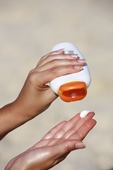Home > Press > Making a common cosmetic and sunblock ingredient safer
 |
| Using a particular type of titanium dioxide in sunblock and cosmetics could reduce the potential health risks associated with the widely used compound. Credit: Hemera/Thinkstock |
Abstract:
Using a particular type of titanium dioxide — a common ingredient in cosmetics, food products, toothpaste and sunscreen — could reduce the potential health risks associated with the widely used compound. The report on the substance, produced by the millions of tons every year for the global market, appears in the ACS journal Chemical Research in Toxicology.
Making a common cosmetic and sunblock ingredient safer
Washington, DC | Posted on September 25th, 2013Francesco Turci and colleagues explain that titanium dioxide (TiO2) is generally considered a safe ingredient in commercially available skin products because it doesn't penetrate healthy skin. But there's a catch. Research has shown that TiO2 can cause potentially toxic effects when exposed to ultraviolet light, which is in the sun's rays and is the same kind of light that the compound is supposed to offer protection against. To design a safer TiO2 for human use, the researchers set out to test different forms of the compound, each with its own architecture.
They tested titanium dioxide powders on pig skin (which often substitutes for human skin in these kinds of tests) with indoor lighting, which has very little ultraviolet light in it. They discovered that one of the two most commonly used crystalline forms of TiO2, called rutile, easily washes off and has little effect on skin. Anatase, the other commonly used form, however, was difficult to wash off and damaged the outermost layer of skin — even in low ultraviolet light. It appears to do so via "free radicals," which are associated with skin aging. "The present findings strongly encourage the use of the less reactive, negatively charged rutile to produce safer TiO2-based cosmetic and pharmaceutical products," the researchers conclude.
The authors acknowledge funding from Regione Piemonte.
####
About American Chemical Society
The American Chemical Society is a nonprofit organization chartered by the U.S. Congress. With more than 163,000 members, ACS is the world's largest scientific society and a global leader in providing access to chemistry-related research through its multiple databases, peer-reviewed journals and scientific conferences. Its main offices are in Washington, D.C., and Columbus, Ohio.
To automatically receive news releases from the American Chemical Society, contact .
Follow us: Twitter Facebook
For more information, please click here
Contacts:
Michael Bernstein
202-872-6042
Francesco Turci, Ph.D.
University of Torino, Chemistry Department
“G. Scansetti” Interdepartmental Center and NIS Excellence Center
via P. Giuria 7
10125 Torino
Italy
Copyright © American Chemical Society
If you have a comment, please Contact us.Issuers of news releases, not 7th Wave, Inc. or Nanotechnology Now, are solely responsible for the accuracy of the content.
| Related Links |
| Related News Press |
News and information
![]() Researchers develop molecular qubits that communicate at telecom frequencies October 3rd, 2025
Researchers develop molecular qubits that communicate at telecom frequencies October 3rd, 2025
![]() Next-generation quantum communication October 3rd, 2025
Next-generation quantum communication October 3rd, 2025
![]() "Nanoreactor" cage uses visible light for catalytic and ultra-selective cross-cycloadditions October 3rd, 2025
"Nanoreactor" cage uses visible light for catalytic and ultra-selective cross-cycloadditions October 3rd, 2025
Discoveries
![]() Researchers develop molecular qubits that communicate at telecom frequencies October 3rd, 2025
Researchers develop molecular qubits that communicate at telecom frequencies October 3rd, 2025
![]() Next-generation quantum communication October 3rd, 2025
Next-generation quantum communication October 3rd, 2025
![]() "Nanoreactor" cage uses visible light for catalytic and ultra-selective cross-cycloadditions October 3rd, 2025
"Nanoreactor" cage uses visible light for catalytic and ultra-selective cross-cycloadditions October 3rd, 2025
Announcements
![]() Rice membrane extracts lithium from brines with greater speed, less waste October 3rd, 2025
Rice membrane extracts lithium from brines with greater speed, less waste October 3rd, 2025
![]() Researchers develop molecular qubits that communicate at telecom frequencies October 3rd, 2025
Researchers develop molecular qubits that communicate at telecom frequencies October 3rd, 2025
![]() Next-generation quantum communication October 3rd, 2025
Next-generation quantum communication October 3rd, 2025
![]() "Nanoreactor" cage uses visible light for catalytic and ultra-selective cross-cycloadditions October 3rd, 2025
"Nanoreactor" cage uses visible light for catalytic and ultra-selective cross-cycloadditions October 3rd, 2025
Personal Care/Cosmetics
![]() DGIST and New Life Group launched a research project on "Functional beauty and health products using the latest nanotechnology" May 12th, 2023
DGIST and New Life Group launched a research project on "Functional beauty and health products using the latest nanotechnology" May 12th, 2023
![]() A Comprehensive Guide: The Future of Nanotechnology September 13th, 2018
A Comprehensive Guide: The Future of Nanotechnology September 13th, 2018
![]() Graphene finds new application as anti-static hair dye: New formula works as well as commercial permanent dyes without chemically altering hairs March 22nd, 2018
Graphene finds new application as anti-static hair dye: New formula works as well as commercial permanent dyes without chemically altering hairs March 22nd, 2018
![]() Programmable materials find strength in molecular repetition May 23rd, 2016
Programmable materials find strength in molecular repetition May 23rd, 2016
Safety-Nanoparticles/Risk management
![]() Onion-like nanoparticles found in aircraft exhaust May 14th, 2025
Onion-like nanoparticles found in aircraft exhaust May 14th, 2025
![]() Closing the gaps — MXene-coating filters can enhance performance and reusability February 28th, 2025
Closing the gaps — MXene-coating filters can enhance performance and reusability February 28th, 2025
|
|
||
|
|
||
| The latest news from around the world, FREE | ||
|
|
||
|
|
||
| Premium Products | ||
|
|
||
|
Only the news you want to read!
Learn More |
||
|
|
||
|
Full-service, expert consulting
Learn More |
||
|
|
||








